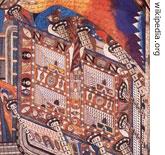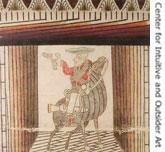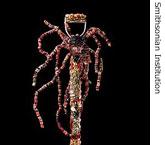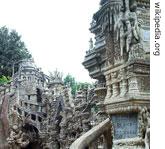VOA慢速英语 2007 0321b
时间:2019-01-11 作者:英语课 分类:VOA慢速英语2007年(三)月
VOICE ONE:
I’m Steve Ember.
VOICE TWO:

Detail from a drawing by Adolf Wolfli from 1910
And I’m Barbara Klein with Explorations in VOA Special English. Today, we travel to several countries exploring the world of Outsider Art. This powerful form of creative expression usually involves art made outside the limits and rules of official culture.
Often, outsider artists have not been formally trained. They use their skills to create visual examples of personal observations, invented worlds, and even severe mental conditions.
(MUSIC)
VOICE ONE:
The Outsider Art movement has many names and forms. Experts debate about the differences between terms such as Naïve Art, Visionary Art, Folk Art, Intuitive Art and Outsider Art. It would be impossible to explain the entire debate, so we will just tell a few stories about some great artists. The art itself will explain what is special about these similar movements.
VOICE TWO:
Mental health experts helped bring public attention to one form of outsider art. For example, in nineteen twenty-one, a Swiss doctor, Walter Morgenthaler published a book about the art of his patient, Adolf Wolfli. Mister Wolfli was one of the early outsider artists who received popular recognition 1. During his thirty-five years in a mental hospital in Switzerland, Mister Wolfli created twenty-five thousand pages of drawings and stories.
Adolf Wolfli was a poor farm worker who was placed in a mental hospital in eighteen ninety-five. He soon started making color drawings that he organized into books. For example, around nineteen twelve he finished a nine-book series called “From the Cradle 2 to the Grave.‿nbsp; In this work Mister Wolfli turned his sad childhood into a magical travel story. He included detailed 3 drawings of maps, creatures, rulers, and even talking plants to help capture this imaginary world. In other books, he recreated and renamed the world and universe. He described this world using songs, poetry, and drawings.
VOICE ONE:
In the nineteen forties the French artist Jean Dubuffet discovered Mister Wolfli’s works and other artists like him. He called this kind of artwork “Art Brut‿which is French for “raw art‿ He described Art Brut as being created from pure and real creative forces. He saw outsider artwork as being free from the worries of competition and social acceptance that define 4 the official art world. He argued that the official culture of museums, galleries and artists had lost its power. Art Brut, he said, was still true and powerful art. Jean Dubuffet soon started collecting this kind of art made by mental patients, prisoners and even children. In nineteen seventy-one he donated his personal collection of Art Brut to the city of Lausanne, Switzerland.
(MUSIC)
VOICE TWO:
One way to learn more about this movement is to explore its artists. The American Folk Art Museum in New York City has several rich and inventive drawings by the self-taught artist Martin Ramirez. Mister Ramirez was born in the Mexican state of Jalisco in eighteen ninety-five. He left his wife and family in the nineteen twenties to find work in the American state of California.
But the United States was going through the economic problems of the Great Depression. As a result, Martin Ramirez was soon homeless and unable to find work. Police picked him up in Northern California in nineteen thirty-one. He was placed in a mental hospital and told he had a severe mental illness. He spent the next thirty-two years in mental hospitals.
VOICE ONE:
But there is a happier side to his tragic 5 story. Mister Ramirez might not have been able to express himself in English, but he could do so with his art. In the late nineteen thirties, he started to collect small pieces of paper including food paper packaging, paper cups and book pages. On the large paper surfaces he pieced together, he drew pictures using colors he made from crushed pencils and crayons.

Detail from "Untitled (Caballero)" by Martin Ramirez. Made around 1950.
Over the years, Mister Ramirez drew hundreds of detailed pictures. The horse and rider is one subject he repeatedly drew. He also drew trains and tunnels. His strong repeating lines show depth and motion. Some of his trains come out of mountains, while others go over bridges.
In the early nineteen fifties, a professor of psychology 6 and art named Tarmo Pasto visited Martin Ramirez. Professor Pasto recognized the artistic 7 value of Mister Ramirez's drawings. He gave him art supplies and even organized exhibitions of his work. Most importantly, he made sure Ramirez's art survived and was not thrown away by hospital workers. The extraordinarily 8 skillful and powerful drawings of Martin Ramirez are now a cultural treasure.
(MUSIC)
VOICE TWO:
Many outsider artists have very successful careers during their lifetime. The artist known as Mister Imagination was born Gregory Warmack in nineteen forty-eight in Chicago, Illinois. He grew up in a poor family. As a young man he made jewelry 9 out of thrown away objects and sold it in local restaurants. One night he was robbed and shot twice in the stomach. At the hospital he fell into a coma 10 and was unable to communicate.

Detail of "Button Cane with Self-Portrait" by Mr. Imagination
He had a dreamlike vision of a bright light. He later said it represented artists from the past entering his body and mind to guide him. He decided 12 that art would be his life goal and soon changed his name to Mister Imagination. He makes artistic statues from bottle caps and other found objects. They have been shown in galleries and museums across the United States.
These include the American Visionary Art Museum in Baltimore, Maryland. This museum has more than four thousand pieces by what it calls "visionary" artists. About fifty works are shown at any one time in its permanent collection.
(MUSIC)
VOICE ONE:
Ku Shu-Lan also enjoyed public recognition of her creations 14. She was born in nineteen nineteen in the Shaanxi area of China. Like many women in the area, Ku Shu-Lan was very skillful at the art of paper cutting. She often had visions of a magical goddess covered in flowers coming to her in a garden. She said the woman was herself, the paper-cutting goddess. Ku Shu-Lan lived with her husband in a cave carved from earth.
There was not much color in her life, so she made her own. She covered the walls of her home with her richly colored cutouts of this goddess. Some of her images have thousands of finely cut shapes. They are so detailed it is hard to believe the images are not painted. In nineteen ninety-six, Ku Shu-Lan fell and hurt herself. She was in a coma and was not able to communicate for several weeks. Her family started to plan for her burial. But, she later woke up. The first thing she asked for was a pair of scissors so she could start another paper creation 13.
VOICE TWO:

Ferdinand Cheval's Ideal Palace
Other outsider artists use their skills to create entire environments. For example, in Hauterives, France, you can see the Ideal Palace made by a mailman named Ferdinand Cheval. One day in eighteen seventy-nine while delivering mail Mister Cheval found a rock with a strange shape. He decided it was a sign that he needed to make his dream of being a building designer a reality. He spent the next thirty-four years of his life collecting stones and building a wildly imaginative 15 palace building. Mister Cheval mixed periods and styles of Chinese, North African, and Northern European architecture. Today, people can visit this building to experience this mailman's hard work and creativity.
VOICE ONE:
Helen Martins created a whole other kind of magical environment in the town of Nieu-Bethesda, South Africa. In nineteen forty-five, Miz Martins found that the world looked gray and colorless. She decided she needed to brighten her life. So, at the age of forty-seven she started to glue crushed colored glass in special designs on every surface in her house. Then, she started making statues out of cement material and glass. She read poetry, religious books, and art history to find ideas for her creations. Helen Martins hired two workers to help her create her Owl 16 House and the surrounding Camel Yard.
VOICE TWO:
By the time of her death in nineteen seventy-six, the yard had more than three hundred statues of animals and imaginary creatures. All of them face east toward the Muslim holy city of Mecca. Visitors can enjoy the brightness 17 and color of the universe she created. Like Helen Martins, outsider artists add new life, imagination and skill to the world of creative expression.
(MUSIC)
VOICE ONE:
This program was written and produced by Dana Demange. I’m Steve Ember.
VOICE TWO:
And I’m Barbara Klein. You can read and listen to this program on our Web site, voaspecialenglish.com. Join us again next week for Explorations in VOA Special English.
- The place has changed beyond recognition.这地方变得认不出来了。
- A sudden smile of recognition flashed across his face.他脸上掠过一丝笑意,表示认识对方。
- The baby was rocked to sleep in a cradle.婴儿在摇篮里被摇得睡着了。
- Tokyo was the cradle of Japanese culture.东京是日本文化的发源地。
- He had made a detailed study of the terrain.他对地形作了缜密的研究。
- A detailed list of our publications is available on request.我们的出版物有一份详细的目录备索。
- Please define the words.请解释这些字的意义。
- It's hard to define exactly what has changed.很难解释清楚到底发生了什么变化。
- The effect of the pollution on the beaches is absolutely tragic.污染海滩后果可悲。
- Charles was a man doomed to tragic issues.查理是个注定不得善终的人。
- She has a background in child psychology.她受过儿童心理学的教育。
- He studied philosophy and psychology at Cambridge.他在剑桥大学学习哲学和心理学。
- The picture on this screen is a good artistic work.这屏风上的画是件很好的艺术品。
- These artistic handicrafts are very popular with foreign friends.外国朋友很喜欢这些美术工艺品。
- She is an extraordinarily beautiful girl.她是个美丽非凡的姑娘。
- The sea was extraordinarily calm that morning.那天清晨,大海出奇地宁静。
- The burglars walked off with all my jewelry.夜盗偷走了我的全部珠宝。
- Jewelry and lace are mostly feminine belongings.珠宝和花边多数是女性用品。
- The patient rallied from the coma.病人从昏迷中苏醒过来。
- She went into a coma after swallowing a whole bottle of sleeping pills.她吃了一整瓶安眠药后就昏迷过去了。
- This sugar cane is quite a sweet and juicy.这甘蔗既甜又多汁。
- English schoolmasters used to cane the boys as a punishment.英国小学老师过去常用教鞭打男学生作为惩罚。
- This gave them a decided advantage over their opponents.这使他们比对手具有明显的优势。
- There is a decided difference between British and Chinese way of greeting.英国人和中国人打招呼的方式有很明显的区别。
- Language is the most important mental creation of man.语言是人类头脑最重要的产物。
- The creation of new playgrounds will benefit the local children.新游戏场的建立将有益于当地的儿童。
- This artist's creations are worth collecting. 这个艺术家的作品值得收藏。
- The intellectual creations of individual nations become common property. 各民族的精神产品成了公共的财产。 来自英汉非文学 - 共产党宣言
- The imaginative child made up fairy stories.这个想像力丰富的孩子自己编神话故事。
- Scott was an imaginative writer.司格特是位富于想象力的作家。
- Her new glasses make her look like an owl.她的新眼镜让她看上去像只猫头鹰。
- I'm a night owl and seldom go to bed until after midnight.我睡得很晚,经常半夜后才睡觉。
- The brightness of the paint has worn off a little.油漆的光泽有些磨损了。
- Her eyes squinted against the brightness.亮光刺得她眯起眼睛。